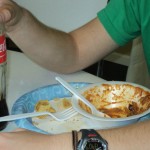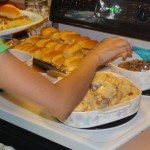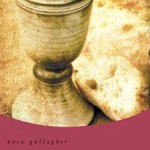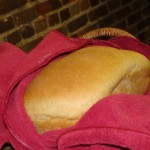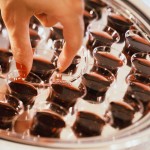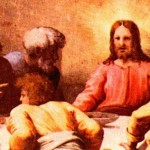Dave Black’s essay on “The Lord’s Supper”
In response to a new book about the Lord’s Supper, Dave Black has written a short essay called “The Lord’s Supper, Then and Now.”
Did you know that the way you partake of “The Supper” demonstrates what you believe about God, Jesus, and the church? It’s true.
In his essay, Black spells out several aspects of modern practices of the Lord’s Supper that are radically different (perhaps even contradictory) to the way the church ate a common meal together as described by the NT authors.
This paragraph is my favorite:
Is it too much to hope that our churches today might return to this biblical model? How can we start to overcome our lethargy? We can only do this, as I have said, when we return to a commitment to obedience. Wherever the church honestly faces its task to be scriptural in all its dealings, believers will discover new ways and means of restoring modern practices to their ancient models. Acts 20:7 underscores this point. Here Luke speaks of a meeting of the church in which the focal point was not a sermon but a common meal. This was apparently the common practice of the early church whenever they gathered on “the Lord’s Day.†Today we gather for “worship†and occasionally tack on the Lord’s Supper almost as an addendum. I imagine this would have appeared very strange to New Testament eyes! The early church knew nothing of worship services or worship centers or worship teams or worship folders. Nor were the earliest gatherings of Christians “top heavy,†leaving the ministry to a handful of selected professionals. Theirs was a one-class society – all saints, all priests, all members of the Christian brotherhood with Christ as their only Head. This is why, I surmise, the Lord’s Supper was so important to them. The Supper offers us an occasion to focus on our Great High Priest, the church’s only Senior Pastor (see 1 Pet. 5:4). Moreover, it seems that the Lord’s Supper was a full meal in New Testament times. Indeed, if we ask ourselves what the word “supper†means, we find that the Greek word used is deipnon, which generally refers to the chief meal of the day. Such is its meaning consistently in the pages of the New Testament. Would it be too radical to suggest that the way in which the Lord’s Supper was observed in the early church – as a full meal – could also be replicated today?
I’ve found that, yes, it is possible for churches today to begin eating the Lord’s Supper as a full meal. But, it is radical, because several things had to change (things mentioned by Black above) before this was possible.
Feasting Together with the Lord
In his continuing series on all things related to “house church,” Eric at “A Pilgrim’s Progress” recently wrote a post called “House Church – The Lord’s Supper Feast.”
First, Eric explains how they eat a meal together during their normal meeting time – everytime they meet together. The meal is an essential part of their gathering, just as essential as singing, praying, and teaching.
Next, he explains that they take the bread and cup as part of the meal, not separately. Finally, he gives us several reasons that he likes eating the Lord’s Supper as a meal:
- It follows the biblical model.
- It’s a full meal. Meals not only taste good, but they also allow for much wonderful conversation.
- The full meal keeps the continuity with the Passover meal (looking backward) and the Marriage Supper of the Lamb (looking forward).
- The full meal is a real celebration instead of a solemn ceremony.
- The one loaf and one cup (pitcher for now) help us remember that we are united in Christ. This spurs and encourages the unity of the body.
- Since the meal takes place right in the same spot as the rest of the gathering, there is no artificial dividing line between the Lord’s Supper and the remainder of the fellowship.
- The church in Troas gathered together for the purpose of breaking bread. We do the same.
Have you ever eaten the Lord’s Supper as a meal? What was your reaction?
Adding Significance to a Symbol
In The Sacred Meal, Nora Gallagher seeks to explain the significance of Communion – the Eucharist – the Lord’s Supper – the Agape Feast. She writes as one who has served the bread and the wine at many communion services primarily in the Episcopal denomination.
I must begin this review with a couple of confessions. First, I grew up in a different Christian tradition with a different understanding of the Supper. Second, I have since come to understand Communion as a completely different “practice” than either of these two traditions (the author’s or my own).
This book is part of a series called “The Ancient Practices Series.” Gallagher explains her understanding of the difference between a “practice” and a “habit”:
To engage in a practice is to show up and not get attached to the outcome. Unlike a habit, like driving down the same street from work to home every day, the purpose of a spiritual practice is to help us stay awake. Hidden in this kind of repetition is the chance that on any given day, the mind or soul will connect with what is waiting to connect to us. (pg xix)
The practice to which she refers is, of course, Communion. In her practice, Communion consists of standing in line with strangers (per the author’s description) to accept a wafer of bread and a sip of wine (or perhaps to dip the bread in the wine).
The book, then, is her attempt to add significance to this practice. She does so by retelling several episodes in her own life around the event of communion. The stories are told in a vivid and easy-to-read fashion which causes the reader to empathize with the author and the other characters in the story.
Gallagher divides her book into eleven chapters and a study guide. She invites her readers to consider the “waiting,” the “receiving,” and the “afterward” of a communion service. She also wants her readers to connect to God through various experiences, including experiences of communion.
The author does manage to attach significance to the symbol of a meal. She attaches significance from the life of Jesus, and from her own life. She presents the symbol of a table that is open to anyone, from alcoholics and drug addicts to the religious elite.
The problem with this book is actually not the author’s problem. The problem lies in the traditional understanding of “Communion.” The author does not tie the significance of “Communion” back to scriptural passages about “Communion.” Why? Because the taking of a wafer and a sip of wine cannot be connected to the meal that we find in the pages of the New Testament.
Thus, today, we must find significance in the symbol of a table, instead of gathering around a real table. We partake of a symbol of a meal, instead of sharing in the Lord’s Supper. We share the elements of the Eucharist, instead of thanking God for the food that we share with one another. We stand in line with strangers for “Communion service,” instead of actually sharing fellowship with our brothers and sisters. We call a wafer and a sip a feast, instead of truly sharing a love feast (Agape feast).
I’m not blaming Gallagher. This search for significance in the “Supper” or “Communion” or “Eucharist” has been going on for many, many years. And, it will continue until we put away the symbols and start sharing in the supper itself… a supper that is a real meal with real people with whom we share real relationships with Jesus as the real host.
(I received this book for free from BookSneeze.com in exchange for this review.)
One Loaf and One Cup
Dave Black needs your help.
He’s collecting examples of how Christians celebrate the Lord’s Supper with one loaf of bread and one cup.
This is what he says (Thursday, December 16, 2010 at 9:34 p.m.):
I need your help. Here’s the need. I’m compiling a list of ways that churches can observe the Lord’s Supper with one cup and one loaf of bread (see 1 Cor. 10:16-17). Any ideas? Have you ever done this? Please send your comments to me at dblack@sebts.edu. Thanks.
I sent him an example of how we’ve gathered around the table with one loaf and one cup, along with other food. Why not send him your example as well?
And, while you’re at it, copy it here for my readers also.
(By the way, does anyone know what Dave is specifically interested in “one” loaf and “one” cup?)
Some ate too much; some got drunk
Please allow me an opportunity for a little levity concerning a very important subject.
Jon at “Jon’s Journey” has written a very good article looking at 1 Corinthians 11 concerning “The Lord’s Supper.”
As I thought about Paul’s admonition that some of the Corinthians were eating too much food while others were going hungry, I applied that to today’s practices. I pictured someone sneaking in and eating most of the little morsels of bread-like substance off of the plates.
Then, as I thought about Paul’s admonition that some were drinking so much wine that they were getting drunk, I also applied that to today’s practices. I pictured someone else sneaking in a drinking most of the wine (grape juice wouldn’t work in this case) from the small glasses and getting drunk.
For some reason, this was a funny image for me.
The Lord’s Supper in Context
A few days ago, I was reading through parts of Margaret M. Mitchell’s Paul and the Rhetoric of Reconciliation: An Exegetical Investigation of the Language and Composition of 1 Corinthians (Louisville: Westminster/John Knox Press, 1991). I came across the section where she was discussing the Lord’s Supper in 1 Corinthians 11:17-34.
Mitchell points out that linguistically the entire passage focuses on the relational problems among the believers in Corinth:
Paul next turns to admonish the Corinthians for behavior in community worship which is even more divisive than the head wear disagreements. He begins this argument with his censure of their improper behavior first named in general terms, and then he describes specifically the abuse which he will treat… (1 Corinthians 11:20-22) Because he returns to this ecclesiological concern in 1 Corinthians 11:33-34, we conclude that the disunity of the church is the main topic of this argument, to which the tradition (1 Corinthians 11:23-26) is a response. (page 263)
If Mitchell is correct, and I believe that she is, then relational divisions during the Corinthian’s shared community meals is the reason that Paul wrote 1 Corinthians 11:17-34. Thus, we should read each part of that passage as building on Paul’s argument against these relational divisions.
For example, when Paul reiterates the account of Jesus’ last supper with his disciples in 1 Corinthians 11:23-26, he intended to admonish the Corinthians about the way they were treating one another. When he told the Corinthians to “let a person examine himself” in 1 Corinthians 11:28, it is in the context of communal relationships, not individual sin (although certainly individual sin causes problems with communal relationships). The same would be true about Paul’s teaching about judging ourselves in 1 Corinthians 11:31-32.
Paul began this section of Scripture by admonishing the Corinthians concerning their behavior when they came together to eat. He ends this section by again instructing the Corinthians about their behavior when they come together to eat. So, in context, we should understand that in this entire passage Paul is concerned about how the Corinthians are treating one another when they come together to share a meal.
We cannot pull parts of the passage out and choose to interpret that differently than the entire passage. Instead, the parts work together within the context of the whole.
Is this how you’ve heard this passage about the Lord’s Supper interpreted? How would it change traditional interpretations that you’ve heard?
Breaking Bread and the Lord’s Supper
So, when we read “breaking bread” in the New Testament, should we assume that the author is talking about “the Lord’s Supper” (or Communion or the Eucharist or whatever it is called in your tradition)?
We find Jesus “breaking bread” in the feeding of the 5000 and the feeding of the 4000:
Then he ordered the crowds to sit down on the grass, and taking the five loaves and the two fish, he looked up to heaven and said a blessing. Then he broke the loaves and gave them to the disciples, and the disciples gave them to the crowds. (Matthew 14:19 ESV; see also Mark 6:41)
[H]e took the seven loaves and the fish, and having given thanks he broke them and gave them to the disciples, and the disciples gave them to the crowds. (Matthew 15:36 ESV; see also Mark 8:6)
Similarly, the phrase “break bread” is used in the accounts of Jesus last meal with his disciples before the crucifixion:
Now as they were eating, Jesus took bread, and after blessing it broke it and gave it to the disciples, and said, “Take, eat; this is my body.” (Matthew 26:26; see also Mark 14:22; Luke 22:19)
Jesus also “broke bread” after walking along the road to Emmaus with two disciples:
When he was at table with them, he took the bread and blessed and broke it and gave it to them. (Luke 24:30 ESV; see also Luke 24:35)
In Acts 2:42 and Acts 2:46, Luke tells us that the church “broke bread” together daily after Pentecost:
And they devoted themselves to the apostles’ teaching and fellowship, to the breaking of bread and the prayers. (Acts 2:42 ESV)
And day by day, attending the temple together and breaking bread in their homes, they received their food with glad and generous hearts… (Acts 2:46 ESV)
Paul met with the church in Troas when they got together to “break bread”:
On the first day of the week, when we were gathered together to break bread, Paul talked with them, intending to depart on the next day, and he prolonged his speech until midnight. (Acts 20:7 ESV)
And when Paul had gone up and had broken bread and eaten, he conversed with them a long while, until daybreak, and so departed. (Acts 20:11 ESV)
When Paul was on a ship in a storm for two weeks, he broke bread with the sailors:
And when he had said these things, he took bread, and giving thanks to God in the presence of all he broke it and began to eat. (Acts 27:35 ESV)
Finally, Paul wrote to the Corinthians about “breaking bread” twice, once a repetition of Jesus’ words at his last meal with his followers:
The cup of blessing that we bless, is it not a participation in the blood of Christ? The bread that we break, is it not a participation in the body of Christ? (1 Corinthians 10:16 ESV)
[A]nd when he had given thanks, he broke it, and said, “This is my body which is for you. Do this in remembrance of me.” (1 Corinthians 11:24 ESV)
As far as I can tell, these are all the passages in the New Testament that refer to “breaking bread.”
There’s also an interesting occurrence of the phrase “break bread” in Jeremiah – doubly interesting because it also includes reference to a “cup”:
No one shall break bread for the mourner, to comfort him for the dead, nor shall anyone give him the cup of consolation to drink for his father or his mother. (Jeremiah 16:7 ESV)
So, which of these instances of “break bread” do you think definitely refers to “the Lord’s Supper”? Which ones definitely do NOT refer to “the Lord’s Supper”?
Activities during the gathering of the church
Four years ago, when I first started this blog, I wrote a post called “Activities during the gathering of the church.” I think Paul makes it clear in 1 Corinthians 11 (when speaking of the Lord’s Table/Supper) that activities themselves do not produce a “successful” meeting of the church. I think this applies to other activities as well.
——————————————
Activities during the gathering of the church
Most books on ecclesiology are surprisingly silent concerning the actual gathering of the church. In many cases, the gathering is assumed, and there is no distinction made between ethical requirements for individuals and requirements for the body as it is assembled. (Note: One notable exception is David Peterson’s book, Engaging with God. However, Peterson’s book is not a study in ecclesiology per se, but a biblical theology of worship. It is an excellent read!)
When ecclesiologies do examine the gathering of the church, they usually turn immediately to proper activities that constitute “worship.” (Again, there is rarely any distinction made between “worship” and the “gathering of the church.” They are usually assumed to be synonymous.)
Should proper activities be our first concern when we consider the church assembled? It is true that many Scripture passages discuss the practices of the NT church: Acts 2:42-47, Acts 11:26, Acts 20:7, 1 Corinthians 5:4, 1 Corinthians 11:17-34, 1 Corinthians 14. More importantly, is God, first and foremost, concerned that we are including the proper activities during our church gatherings?
In Acts 20:7, Luke tells us that Paul spoke to the disciples in Troas when they came together on the first day of the week “to break bread.” This is usually seen as an indication that the church gathered to participate in the Lord’s Supper weekly. This is confirmed in other passages, especially 1 Corinthians 11. However, in 1 Corinthians 11, Paul teaches the Corinthians (and us!) something very important. He says:
Therefore when you come together in one place, it is not to eat the Lord’s Supper. For in eating, each one takes his own supper ahead of others; and one is hungry and another is drunk. (1 Corinthians 11:20-21)
Paul indicates that the Corinthians were gathering to partake of the Lord’s Supper – they were eating and drinking. However, Paul says it was not the Lord’s Supper in reality, because they came together with wrong motives, wrong attitudes, and in wrong relationships with one another. The activity itself did not constitute a proper gathering!
Perhaps when our churches gather, there are more important matters than what activities we should include in our gatherings. We must continue to study Scripture to see what God says about our gatherings!
Reading the Gospel of John Together
Earlier this week, I wrote about our church meeting last Sunday. (see my post “Meeting Around the Table of the Lord“) After publishing that post, I remembered that there was another time 3 years ago that we had the bread, then a meal, then the cup as part of our meeting. But, that time was a different kind of meeting. That was a meeting set aside to reading through the entire Gospel of John in one night. Here is what I wrote about it 3 years ago in a post called “Reading John“. (By the way, as we’re finishing our study of the Gospel of Matthew, we’ve talked about getting together to read through that entire Gospel in one sitting also.)
———————————————
Last night, our family gathered with about 40 other brothers and sisters to read the Gospel of John. The family that hosted last night also hosted a reading of the Gospel of Luke in December. Our family was not able to attend the reading of Luke, so this was our first time to sit through a community reading of a gospel.
We started by breaking bread as part of the Lord’s Supper. Then, we all shared a meal. After the meal, we sang a song and began reading John. One person read each chapter (the chapters had been assigned as people arrived). After each group of seven chapters, we took a fifteen minute break. During the breaks, we would eat and sing songs again. After reading all twenty-one chapters, we shared the cup of the Lord’s Supper.
This was a very special time for us. It was amazing to hear the Gospel of John read in one sitting in a community of believers.
Meeting around the Table of the Lord
I’ve written several times on this blog about the Lord’s Supper, or Communion, or the Eucharist, or whatever you want to call it. I’ve talked about how the Lord’s Supper is described as a meal in Scripture. I’ve also written about how we usually eat together when we gather with the church.
Still, though, there has usually been a disconnect between our meeting together, the bread/cup, and eating a meal together. I’ve often thought about how this disconnect could be remedied.
Last Sunday – yes, Easter Sunday – we had an opportunity to meet in a different way that brought together the bread/cup, a meal, and our whole meeting.
We began by meeting around tables. People knew that we would be eating together, so they brought food with them – rows of crock-pots, casseroles, dishes, and other assorted goodies. We then milled around and talked and discussed our week and different things like that.
Eventually, one of our brothers started leading us in some singing. Since it was Easter, and since we were planning to study the resurrection passage in Matthew 28:1-17, we sang several songs about the resurrection. We’re also reading through Acts together, so at one point two brothers read from Acts 18, one reading the first half of the chapter, and another reading the second half of the chapter.
After a few songs, we talked about the significance of the bread and breaking the bread. We talked about how the bread signified both Jesus’ broken body as a sacrifice on our behalf, and how the broken bread signifies the beginning of our meal with Jesus as our risen, living host. It remains his table, not ours.
Since I was planning to lead our discussion of Matthew 28:1-17 that morning, I suggested several questions that people could discuss together around their tables as they were eating.
Then, after we broke and shared the loaf of bread together, we began eating. As we ate, we discussed the questions that I suggested. After most people had finished eating, and while a few were finishing dessert, I asked each table (we had five tables) to share something about their discussion.
Next, I read and led a discussion of Matthew 28:1-17. Of course, our discussion around the table led into this teaching/discussion. Since people had already been talking about the issues in smaller groups, it seemed our larger group discussion was even more open and focused on the topic.
Finally, after a few announcements, we passed around the “cup” (actually a bottle of grape juice) and shared this together.
There are many ways for the church to meet together. I really appreciated the way we met together last Sunday. I liked the way that our meeting format combined the bread, cup, meal, and teaching all together in a unified format. The bread/cup and meal were not “tacked on” to the meeting, but were an integral part of our meeting together.

